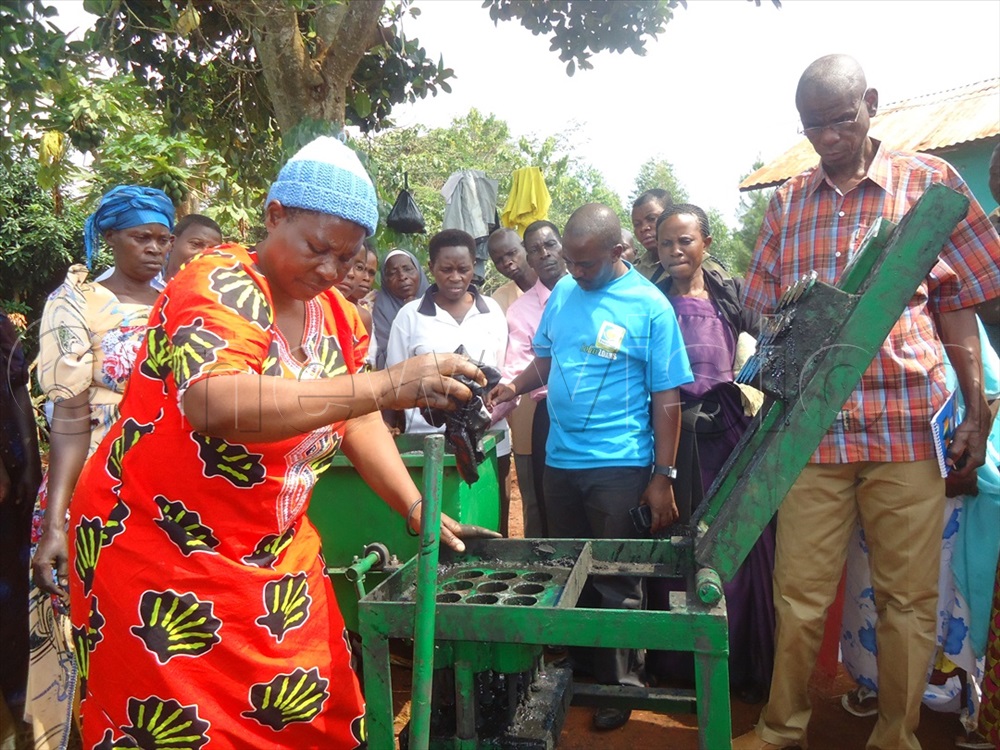By Umar Nsubuga
Freddie Dembele forks out sh100,000 every month to purchase charcoal, a common biofuel used in both rural and urban places to prepare food, throughout most of Uganda.
To his chagrin, most of the charcoal is wasted, especially after cooking, as the burning coals are left to burn incessantly until they deplete.
Back in the village where the coals come from, thousands of trees have been cut already, to make charcoal, because the business is booming in town.
Dembele is now meditating on whether to join the business for profit, but the realisation that he would be directly participating in the destruction of the environment holds him back.
Millions of trees all over Uganda, are destroyed every year, to make biomass such as charcoal, a matter that experts say is fast accelerating the negative effects of climate change.

This has forced prof Kant Kanyarusoke and his wife Sheila Kanyarusoke the CEO of Renewable Energy for Food and Water Engineering Farm Ltd to cry out to government to popularise the adoption of bio briquettes as an alternative source of fuel for charcoal.
Kanyarusoke, an environmental advocate and tree farmer in Kyegegwa district, believes that promotion and adoption of briquettes can sufficiently counter the use of charcoal to save the environment.
He says the use of briquettes can easily mitigating the negative environmental, social and economic impacts resulting from charcoal production.
“Production of carbonized briquettes is the way to go in Uganda, and should be massively supported by the government. If you look critically, the government spends a lot of money treating illnesses related to use of charcoal. We also lose a lot of people and resources every year, because of this,” he says.
In addition, he says, smoke generated from cooking with wood fuels and charcoal contributes to household pollution which can have negative effects on our respiratory systems.
Kanyarusoke, adds that more than 18,000 people in Uganda, mostly women and children, die every year due to suffocation from solid fuels, which must be fought through advocacy for clean cooking solutions.
“The cause of the organisation is very crucial for the health of our people, but what will happen to it if the donors decide to pull their funding? How will it survive? Therefore, they must find nontraditional ways of funding the activities of the association,” he said.
In Uganda, biomass energy accounts for about 90 percent of the total primary energy consumed through firewood, charcoal and crop residues.
In its Vision 2040 however, Uganda aspires to shift progressively from dependence on solid biomass for energy to modern, clean energy alternatives such as solar, electricity and Liquefied Petroleum Gas (LPG), in line with global development goals, which aim to achieve universal access to clean energy.
However, due to logistical and technical constraints associated with clean energy alternatives, the shift remains a challenge.
According to the National Forestry Authority, forest cover in Uganda is fast diminishing, shrinking at a rate of 55,000 hectares per year.
The authority says 70% of the 4.9 million hectares of Uganda’s forest coverage is mainly woodland grown on private lands and is experiencing high rates of clearance for agriculture and charcoal production.
The authority says the country has witnessed a staggering depletion of the natural forest cover from 24% in the 1990s to a shocking 8% in 2019.
According to the World Health Organization (WHO), nearly 20,000 deaths are attributed annually to indoor air pollution from solid fuel use, which is responsible for approximately 5% of Uganda’s national burden of disease.
In its vision for 2040, the government intends to make clean energy a substantial part of the national energy consumption, with increased consumption of more than 50% of the total energy consumption by the year 2017.
A 2020 Forestry Outlook Studies in Africa (FOSA) report indicates the country’s forest estate shrunk from 30% of the total land area in 1990 to approximately 15.2% in 2020, with privately owned forests affected the most.
The forests, according to FOSA, are mostly cleared for burning charcoal and supply of poles, especially Eucalyptus, to the booming construction sector.
The report estimates that at least 75,000 ha of timber plantations are needed just to meet the projected internal timber demand by 2025.
Uganda has excellent conditions to support commercial tree growth. With good management and the adoption of intensive silvicultural practices, growth rates can match the best in the world and there is also a solid return on investment, the report states.
According to Kanyarusoke, briquetting is the easiest and most economical technology to solve Uganda’s energy problems without abusing the environment.
He says the technology is not harmful to the users in comparison with wood charcoal which emits smoke, and harmful gases.
He says they have also been identified as a plausible and close alternative to commonly used energy fuels such as charcoal and firewood whose prices are escalating due to the dwindling natural resource base.





